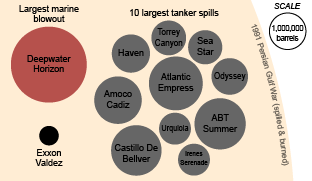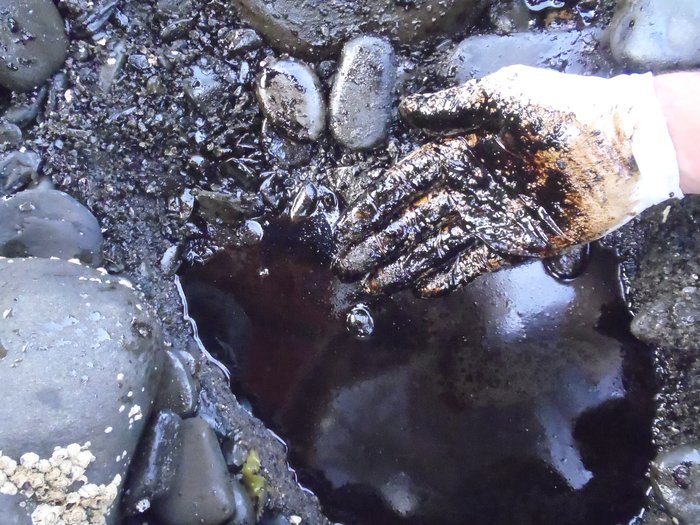
Summary
The 1989 Exxon Valdez Oil spill released millions of gallons of crude oil into Prince William Sound Alaska. It was the worst environmental disaster in Alaska history, and occured in a very sensitive coastal ecosystem, magnifying damage. The spill immediately resulted in the death of oiled wildlife and significant reductions in tourism, recreational fishing and commercial fishing. Long-term direct effects of the spill include lingering oil with associated negative impacts on the ecosystem. Some marine animal populations have still not recovered to pre-spill levels.

The Accident
In March 1989, The Exxon Valdez oil tanker grounded on Bligh Reef in Prince William Sound Alaska, perforating its single hull, and releasing 10.1 million gallons of crude oil into the water, over the course of five hours. Over time, the total spill estimate has settled around 11 million gallons, but this number is disputed. The spill affected over 1,100 miles of coastline.
The cause of the spill was determined to be human errors, including inadequate rest by crewmembers and failure to repair broken equipment. Exxon initially directed most of the blame at the captain, Joseph Hazelwood, but multiple subsequent legal judgments found Exxon (now ExxonMobil) at fault. As a result of the subsequent monetary settlements, an organization called the Exxon Valdez Oil Spill Trustee Council (EVOSTC) was created to oversee research on the oil spill. Active cleanup was pronounced complete in 1992 but extensive research on the effects of the spill continues to this day.
Short-Term Effects
The very visible deaths of tens of thousands of seabirds, thousands of sea otters, hundreds of harbor seals and eagles, and more than 20 orca whales gained the intense public attention. Less visible was the destruction of billions of salmon and herring eggs, as well as algae and invertebrate populations.
Tourism was noticeably affected in the years after the spill, with estimates of lost revenue into the hundreds of millions of dollars. Some businesses, such as fishing lodges and wildlife charters, were severely impacted, and others, such as motels and caterers, actually benefited from the massive influx of cleanup personal to the area.
The spill heavily impacted recreational fishing. The cost to the industry in 1989, due to cancellation of charter trips and the use of fishing boats for cleanup efforts, was estimated at $3.6 to $50.5 million dollars.
Commercial fishing for salmon, herring, crab, shrimp, rockfish, and sablefish was closed after the spill throughout Prince William Sound, as well as in Cook Inlet, the outer Kenai Coast, Kodiak, and the Alaska Peninsula. The closures of parts of the salmon and shrimp fisheries in Prince William Sound were extended into 1990. These closures had a large and immediate economic impact in Alaska. Lingering perceptions among consumers of petroleum contamination in Alaskan wild fish and shellfish may have further depressed sales for years. While most of the fisheries have recovered, the herring fishery in Prince William Sound has been closed for more than 20 of the 25 years since the spill.
Long-Term Effects
Numerous studies in recent years have highlighted ongoing effects of the spill–still felt many years after obvious effects faded in Prince William Sound. These include direct effects of the remaining oil, delayed population loss from sublethal doses of oil that affect growth and reproduction, and indirect effects of changes in the food web of the region. Concerns also still persist about the effects of lingering oil on shellfish in the area, particularly for subsistence harvesters. Buried oil persists 25 years later in the Sound’s beaches, where it is protected from weathering and surf action.

A detailed 2001 National Oceanic and Atmospheric Association NOAA survey of affected beaches found oil at over half of the 91 sites tested, some of which was in the same un-degraded form as within a few weeks after the spill. The amount of remaining oil was estimated at around 21,000 gallons and is decreasing at the rate of 0-4% per year. Residual oil has even been found as far as the Kenai Peninsula and even the Katmai coast 450 miles away. Finding presented at the International Oil Spills Conference 2014 confirmed the continued proesence of undegraded oil 25 years after the spill (paper not currently available).
A 2003 review of dozens of studies showed that significant environmental effects were still being felt on some beaches in Prince William Sound and estimated that mussel beds, for example, wouldn’t fully recover for another 30 years. EVOSTC maintains a list showing the recovery status of a number of affected species. As of 2014, it listed two species (including Pacific herring) as “not recovered”, seven species and the intertidal ecosystem assemblage as “recovering” and 11 species and subtidal ecosystem assemblage as “recovered” or “most likely recovered”. Two species are also listed as “recovery unknown” due to insufficient data. EVOSTC classifies most human activities (such as commercial fishing and subsistence harvesting) and natural zones (sediments and designated wilderness areas) to be “recovering” while only archeological sites are said to be “recovered”.
Changes after the spill
The shock of the Exxon Valdez spill spurred a large number of regulatory changes within the oil industry and the state. The oil industry instituted drug/alcohol testing for tanker crew, modified tanker routes, increased training and inspection regimes for crew, improved navigational equipment, and installed redundant power systems on their vessels. Spill response technology has also improved, through new techniques and equipment, the creation of oil spill response centers, and the adoption of more detailed oil spill contingency plans. Alaska now requires that tankers in the Gulf of Alaska be escorted by tugs, and bars ships that have had oil spill problems from entering the Gulf. The US Congress passed legislation requiring all tankers to have double-hulls by 2015.
These changes, and others worldwide, have resulted in a large decrease in the number and size of oil tanker spills in the last two decades. However, oil tanker spills still released over 260 million gallons of oil in the 1990’s and over 50 million gallons in the 2000’s. Within Prince William Sound itself, oil tankers have lost power and had to be rescued at least four times since 1989, highlighting the still-remaining risk.
The Exxon Valdez was never again permitted to enter Prince William Sound, the route it had been built to service. The Valdez subsequently passed through a handful of owners, being renamed the Exxon Mediterranean, Sea River Mediterranean, S/R Mediterranean, Dong Fang Ocean, and finally the Oriental Nicety. On August 2, 2012 it was beached at Alang, India, the world’s largest ship breaking yard. It was subsequently broken into scrap.
Legal settlement
In 2008 the US Supreme court issued a ruling that limited punitive damages levied against Exxon to $500 million out of an estimated $2.5-5 billion. This ruling, almost 20 years after the spill, gave relief to some affected residents that their long legal saga was over. However, more common reactions were disbelief, anger, disappointment, and disillusionment. Some fishermen and residents had passed away in the intervening years, others had long ago gone bankrupt or turned to other endeavors. Many people received only a pittance of what they were expecting or felt they were owed.
Further Reading
- > Wikipedia article on the Exxon Valdez spill
- > Exxon Valdez Oil Spill Trustee Council website
- > Exxon Valdez Oil Spill Trustee Council 2009 Status Report
- > Encyclopedia of Earth article on the spill
- > Exxon Mobil page on the Valdez spill
- > Not One Drop: Betrayal and Courage in the Wake of the Exxon Valdez Oil Spill by Riki Ott (2008). Published by Chelsea Green Publishing. 352p.
- > The Spill: Personal Stories from the Exxon Valdez Disaster by Stan Jones and Sharon Bushell (2009). Published by Epicenter Press. 288p.<br /><br />
Created: Jan. 19, 2018